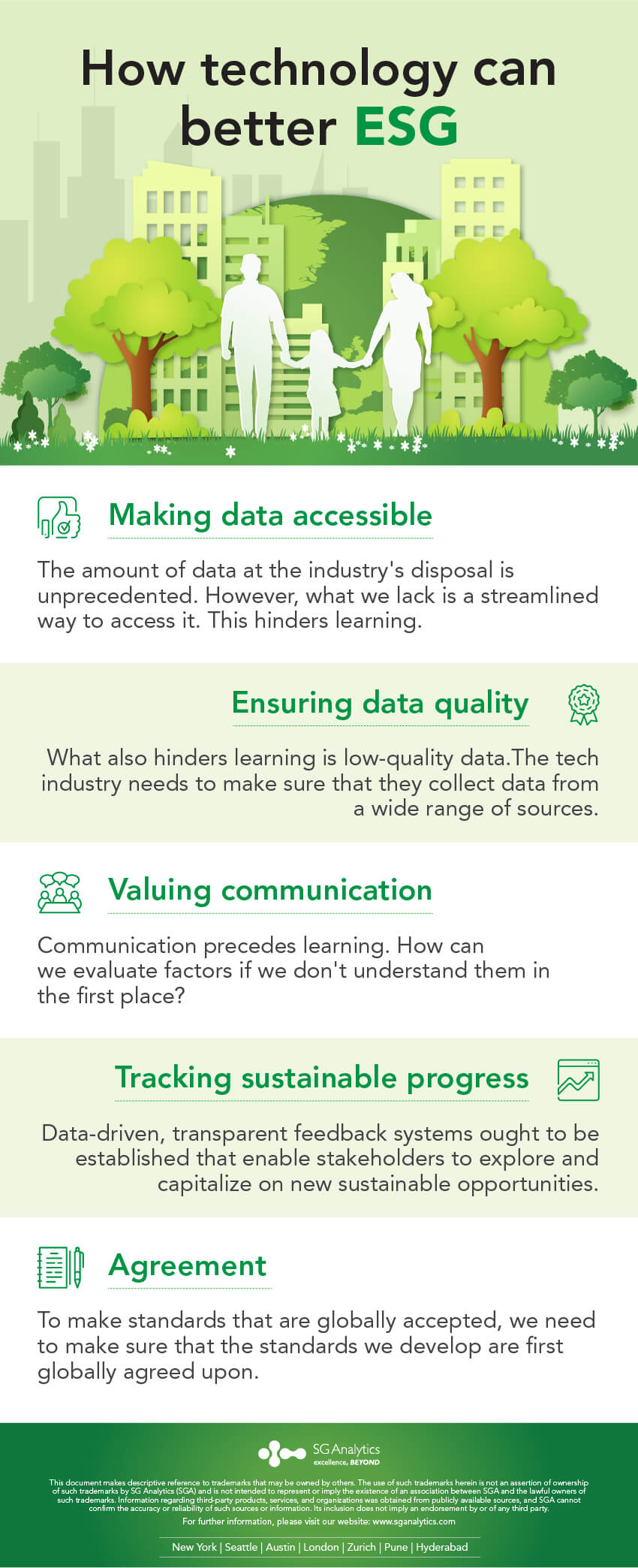According to KPMG, 74% of technology CEOs believe that it’s their responsibility to establish policies that are in line with the values of their customers and investors.
More than half of the CEOs expressed a vision that looks beyond financial growth.
Instead of chasing short-term profits, tech CEOs want to build on long-term, sustainable growth.
Of course, investing in sustainability is not new.
After a causal link between tobacco and cancer was established, and the adverse health effects of pollution became clearer, many investors, for political or religious reasons, refused to invest in tobacco, oil, and liquor assets.

Decades later, our understanding of how human acts affect the environment has never been more thorough. Many people may deny it, but climate change is real.
However, we also have a thorough understanding of how our prejudices affect our decision-making.
Whether it’s law, management, finance, or entertainment, discrimination against minorities, women more so, has prevented them from getting equal opportunities. They only ask for what’s fair.
The very biases and unethical political commitments have also led the people at the top to engage in unethical or even unlawful practices, shunning human responsibility, transparency, and accountability, thereby setting a terrible example for leadership.
The result is an investment ideology that goes beyond avoiding tobacco, oil, or liquor. It’s called ESG — Environmental, Social, Governance — and it stands for something extraordinarily broader.
ESG represents all the factors that define long-term, sustainable growth. Complying with them could lead to a future that is clean, equal, and transparent.
If Big Tech permits.
Big Tech’s recent love for ESG
The keynotes of Apple and Google have been increasingly inclusive over the years. Whether it’s using new products and features or showcasing them, demos have had equal representation of minorities. More women. More women of color and different ethnicities.
The message is clear: we value diversity.
Big Tech — Apple, Amazon, Facebook, Google, Microsoft, for those who don’t know — also never fails to stress its positive impact on the environment.
The impact indeed has been profoundly positive. Or at least that’s the promise.
Google has claimed that it will become carbon-free by 2030. In fact, the term Google used was carbon negative, which means that it will compensate for the carbon emissions it has produced since its inception in 1998.

The goal is incredibly ambitious given the volume of emissions Google’s servers produce. The servers are spread throughout the world and can take acres of space. As part of their plan, Google optimizes them for space and performance, which generates heat.
Others are not far off.
Microsoft and Apple, too, have committed to going carbon negative by 2030.
Apple, in fact, claims that its corporate operations have already achieved carbon neutrality. What’s left are its manufacturing units, supply chains, and the life cycle of its endless variety of products.
Amazon — yes, Amazon, which is inextricable from the mess of goods and plastic and waste — has committed to the same goal. Though Amazon plans to achieve it by 2040.
That said, is Big Tech doing enough?
Sure, their strategy will shape a future that is clean — the E. But what about the S and the G? Surely, they plan to make it equal and transparent as well?
Is the tech industry really promoting sustainable causes, or is it greenwashing?
Avoiding greenwashing, or faux-ESG funds
Greenwashing is the practice of exaggerating one’s ESG quotient.
As we have explained in detail in our blog “Greenwashing” Is Misleading ESG Investors – Understanding the Gray Areas, greenwashing is achieved by either,
Excluding or obfuscating information that may negatively affect an ESG score.
Or,
Including extremely few green prospects, and yet labeling the entire fund sustainable.
There’s a good reason why businesses and fund managers engage in greenwashing. It’s called money.
You see, ESG is quite the sensation. Even the mention of the term in the title of a press release makes headlines.
Bloomberg claims that global ESG assets are worth more than 30 trillion USD today. According to Refinitiv, that’s a nearly five-fold increase since 2005.
But that’s not it.
The sensation that ESG is, Bloomberg claims that ESG assets will cross the 53 trillion USD mark by 2025.
More investors today want to invest responsibly. They want to invest in corporations that are sustainable. Whether they truly are is beside the point. But there’s a clear incentive in claiming to be.

Consider Big Tech.
Sure, Apple plans to go carbon negative by 2030.
But what about its anti-competitive tactics on its App Store? What about the lax safety standards and labor law violations in China’s largest iPhone factory?
Sure, Amazon, the poster child of consumerism, encouraging mining, the abuse of rare metals, and wastage of water, has committed to neutralizing its carbon footprint.
But what about the constant accusations of poor working conditions and exploiting labor? Worse yet, busting unions.
Google, too, has faced heavy criticism lately for its anti-competitive practices on its search engine and for busting unions. Let’s not forget its bias-riddled AI that produces stereotypical results for searches related to minorities.
Facebook might become more diverse, but it still monetizes personal, sensitive information. Further, it has been a victim of data leaks on several occasions now. Isn’t privacy for all a sustainable cause?
As we said, the tech industry is more E than S and G. And yet it calls itself sustainable.
Consequently, fund managers also label entire assets ESG even though they are only partially sustainable. As Climate Bonds Initiative discovered, nearly one-third of all ESG assets are greenwashed.
It’s hard to say how many of those assets belong to the tech sector.
But in making sustainable change, or at least convincing stakeholders of it, the tech sector surely has it better than, say, the energy sector.
If you mine oil for a living, your principles are incompatible with the principles of sustainability. On the other hand, if you are from tech, you can simply change your product.
If you used coal energy to power servers, you can use solar energy now.
Big Tech is more adaptable, and hence, generates higher returns. The highest, in fact, of all ESG assets.

But given its technological prowess, it ought to do better. It ought to do more.
The KPMG study that found that 74% of tech CEOs feel personally responsible regarding bringing sustainable change also found that only 45% actually do it.
How technology can better ESG and vice versa
ESG might be a sensation, a rage, but it’s still unclear, even controversial.
The problem is, we lack established standards or metrics that can distinctly identify which assets or offerings qualify as sustainable and which are greenwashed.
Currently, data analytics and consulting firms gauge ESG compliance by developing their own ESG quotient or ‘score’.
At SG Analytics, for example, ESG consulting involves the identification and analysis of thousands of factors to drive sustainable growth.
One way to overcome the challenge is to regulate the sector.
Already, the European Union Sustainable Finance Disclosure Regulation (SFDR) has entered its first phase of implementation, demanding financial players to explain in detail how they evaluate ESG factors in their products and assets.

The pressure should encourage transparency, which would prevent greenwashing.
Another way is that the tech industry comes together and leverages cutting-edge tools like machine learning and AI to drive sustainability of their own volition.
How? By —
Making data accessible
The amount of data at the industry’s disposal is unprecedented. However, what we lack is a streamlined way to access it. This hinders learning.
Ensuring data quality
What also hinders learning is low-quality data. The tech industry needs to make sure that they collect data from a wide range of sources.
Further, those sources ought to be documented, so that transparency and accountability are maintained.
Valuing communication
Communication precedes learning. How can we evaluate factors if we don’t understand them in the first place?
The tech sector ought to develop methodologies that maximize communication value. Expectations ought to be actively, and clearly, stated.
The tech industry can help the cause by implementing data intelligence and visualization techniques that communicate complex ideas visually, and therefore, make them more intuitive and easier to comprehend.
The increase in clarity leads to an increase in trust.
Tracking sustainable progress
Data-driven, transparent feedback systems ought to be established that enable stakeholders to explore and capitalize on new sustainable opportunities.
Without defined parameters like KPIs, communication and learning run the risk of turning meaningless.
To ensure accountability, we need progress or failure to be traceable.
Agreement
To make standards that are globally accepted, we need to make sure that the standards we develop are first globally agreed upon.
There’s no question that we possess the technology and intellect to transform the world, to transform lives at the scale of individuals.
The question is, will the tech industry accept the responsibility to make the change good and positive.
E — but S and G, as well.









